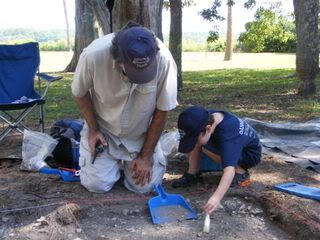
(Picture of DH and Blaze taken last Summer during the field school open-house at Kingsley plantation.)
Thursday afternoon, we went to Kingsley Plantation on Fort George Island, just north of Jacksonville, because the Audubon Society had hired DH to show a group of people around the areas that have been excavated by the University of Florida Summer Field School there and tell about the history of the plantation and what the archaeologists have found.
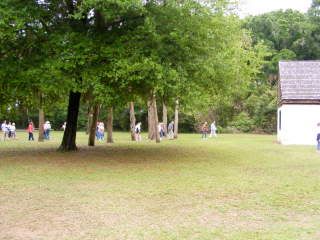
(DH leads the group behind the barn to the place in the woods, where this past summer they discovered the remains of a sugar mill)
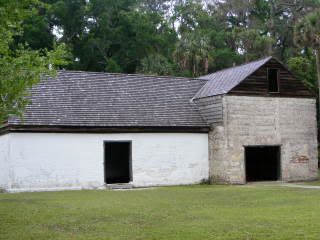
(The barn)
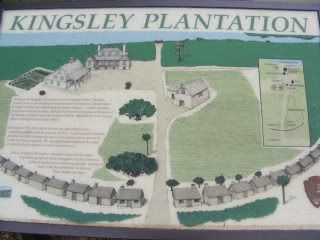
Kingsley Plantation was once the home of Zephaniah Kingsley, a former slave trader, turned farmer. It was also the home of many slaves, who lived in the 32 cabins that were built in a large half circle on the property.
Although the National Park Service has done some restoration work on Kingsley's house, it is the slave cabins that have mostly been the focus of the University digs (there is another group of students that has also been working on an old Spanish mission elsewhere on the island). Some of the cabins are still partially intact and one has been restored by the Park Service, to show what they were like when people still lived in them, but the ones the students are working on, are the ones no longer visible above ground.
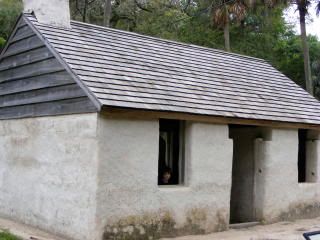
(The restored cabin)
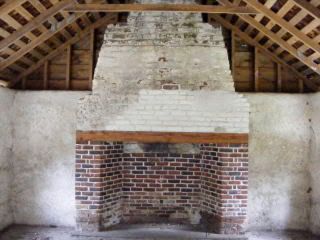
(Inside one of the two rooms of the restored slave cabin)

(Looking into the second room of the slave cabin. Blaze drawing with a stick on the dirt floor)
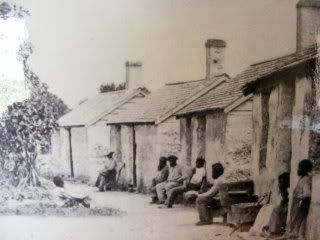
(this picture, taken after the Civil War, shows what the cabins looked like when they were still habitable.)

(This is what the cabins look like today. Some of them were broken up for building material when a later owner wanted to build a boat house)
The cabins were built out of Tabby, an oyster shell concrete.

The layout of the cabins is one of the things that makes Kingsley Plantation unique. Most Southern plantations had cabins built in straight lines. The semi-circle is an African design.
The students have found some interesting things at the cabins, as well. A ritually buried chicken on top of an egg was found under the door of one cabin (possibly a blessing for the house).
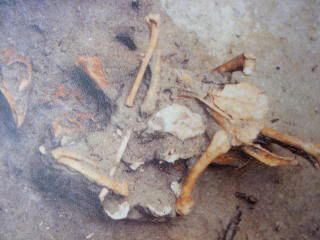
Quality French gun flints have also been found at the cabins, which shows that the slaves were armed.
There were two different ways that slave owners on plantations organized their workers. One was the "gang system", which was the most common system on tobacco, sugar, and large cotton plantations. Slaves were organized into gangs who worked all day under the close supervision of an overseer. The other system , which was the one used by many coastal plantations, including Kingsley's, was the "task system". It meant that when a slave finished a required task, the rest of the day could be spent hunting, fishing, or gardening for his own family.
Although Kingsley was a slave trader and profited from the ownership of slaves, he seemed to have a complicated view of the morality of holding Africans in bondage.
In 1828 he wrote, "Our laws to regulate slaves are entirely founded on terror...The laws of the southern states are exclusively constructed for the protection of whites, and the vexatious tyranny over the persons and properties of every colored person..."
He then added, "Few I think, will deny that color and condition, if properly considered, are two very separate qualities."
Kingsley believed that African slaves were necessary to any successful plantation in Florida, because he thought that they were far more suited to life in a tropical climate than whites.
In 1806, before he had moved to Fort George Island, Kingsley traveled to Cuba, where he purchased a 13 year old girl from Senegal. The girl's name was Anta Majigeen Ndiaye, but Kingsley called her Anna and married her using an African custom. By the time they reached Florida, Anna was pregnant with their first child.
My understanding, from talking to the U.F. students, is that Anna lived in the kitchen house, not actually in the main house.

(The Kitchen House)
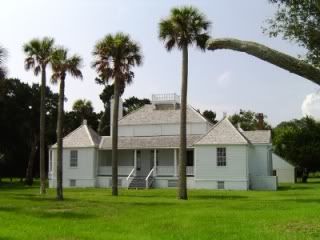
(The "Big" house)
The planter's house has a clever design where the windows are lined up so that the river breezes blow straight through the house, providing natural air conditioning.
When Anna turned 18 Zephaniah Kingsley freed her and their three children. Under Spanish law, as a free woman, she was then able to own her own property. She helped her husband manage his property, as well as owning land and slaves of her own.
Anna and Zephaniah later had another son, who was free from birth, because a child had the status of his mother.
When Florida became an American territory, laws regarding both slaves and free blacks were changed, restricting what free blacks could do, and making interracial marriage illegal. Kingsley opposed these changes, but was unable to stop them, so instead, in 1837, Kingsley, Anna, and their two sons left Florida and moved to the Dominican Republic, so that his family could stay together and his sons could retain their right to inherit from him. Their two daughters remained in Jacksonville and married wealthy white land owners.
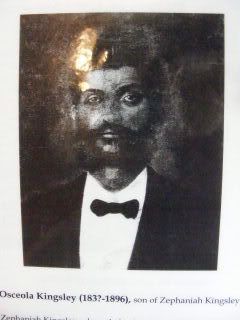

3 comments:
Wow...that was VERY interesting.
There are so many things swirling around in my mind...she was still a slave, though married to him, until the age of 18, their daughters married wealthy white men, oyster shell concrete (never heard of it before), what was found under the door of the one cabin, etc...
The photo that shows the layout of the plantation is fascinating. I am guessing (?) since there were 32 cabins, there must have been a couple of rows of them in the half circle? Or maybe the plantation is actually much larger than it looks in the layout drawing?
Can you imagine the stories that could be told from that time? I wonder if he left any journals...
He did not leave a journal, as far as I know, but I purchased a copy of his nephew's diary at the plantation bookstore.
There was only one row of cabins. It's a really big half circle.
We'll be spending more time there this Summer, so I'll probably be posting more as I learn more.
That was really interesting. I would like to visit!
Post a Comment